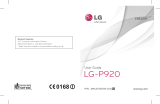
2
Contents
Guidelines for safe and effi cient
use ..............................................6
Important notice .......................16
1. Phone memory .....................16
2. Optimising battery life ...........16
3. Installing an open source OS .17
4. Using unlock pattern .............18
5. Using hard reset ...................19
6. Connecting to Wi-Fi networks 19
7. Opening and switching
applications..........................20
8. Installing the LG PC suite on
your PC ................................21
9. Connecting your phone to a
computer via USB .................22
10. Unlock screen when using
data connection .................24
11. Do not connect your phone
when you power on/off your
PC ....................................24
12. Hold your phone upright .....24
13. If the screen freezes ...........24
Getting to know your phone .....25
Installing the SIM card
and battery ..............................27
Charging your phone ................28
Installing the memory card .......29
Formatting the memory card.....30
Your Home screen ....................31
Touch-screen tips ..................... 31
Lock your phone ......................31
Unlock screen ..........................32
Home .....................................32
Setting the number of home
screens ...................................33
Adding widgets to your home
screen .....................................33
Getting back to a recently used
application ............................... 34
Home preview function .............34
Capturing the screen ................34
Notifi cation drawer ...................34
Viewing the status bar ..............35
Onscreen keyboard ..................37
Entering accented letters ..........37
Google Account Set-up ............38
Creating your Google account ...38
Signing in to your Google
account ...................................38
Calls/Contacts ..........................40
Making a voice call ...................40
Making a video call ..................40
Calling your contacts ................41
Answering and rejecting a call ..41






















